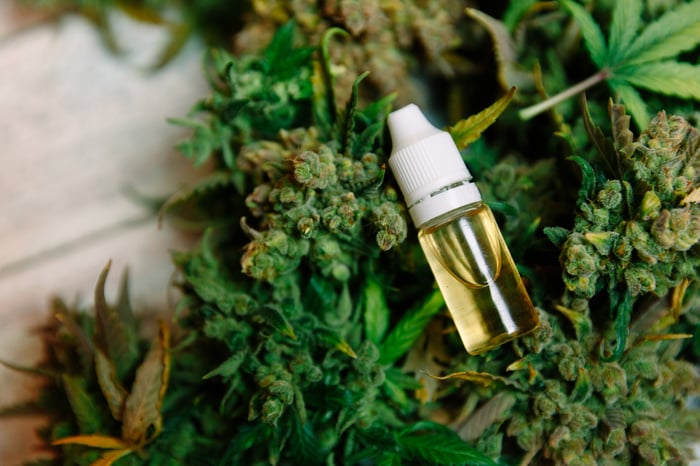You've probably heard by now that marijuana offers investors an incredible long-tail growth opportunity. Having already more than tripled worldwide sales in the past four years to nearly $11 billion, lofty projections call for weed sales to head considerably higher in the years that lie ahead. Plus, with the black market being as large as it is, there's clearly demand waiting to be tapped by legal channels.
But investors are also keenly aware that hot investment trends, like cannabis, need time to mature. These hot investments rarely push into profitability from the get-go, which is exactly what we've witnessed from a majority of the North American pot industry.
To our north, regulatory and procedural issues have substantially hindered the ability of growers to get their product into dispensaries. Meanwhile, in the U.S., certain markets (ahem, California) have taxed the daylights out of their legal pot consumers. The end result is that black-market operators have been thriving. While all of these issues are fixable, it's going to take time for any changes made to take effect.
Thus, the losses continue... that is, unless we're talking about the one niche of the cannabis industry that's already begun to push into the green.

Image source: Getty Images.
Extraction-service providers are seeing little slowdown
Over the past couple of quarters, extraction-service providers have made their presence known to investors. Extraction companies like Valens GroWorks (VLNS), MediPharm Labs (MEDIF -2.85%), and Neptune Wellness Solutions (NEPT -8.82%) provide third-party extraction of hemp and cannabis biomass for their clients. In return, these clients receive resins, distillates, concentrates, and targeted cannabinoids that can be used in the production of derivatives. A derivative is a non-dried-flower pot product, such as edibles, vapes, or infused beverages.
The way I see it, extraction companies have found success for two reasons.
First, derivatives are a much higher margin sales avenue for cannabis companies than dried cannabis flower. In select U.S. states where recreational weed is legal, we've witnessed how oversupply and commoditization can wreak havoc on per-gram pricing. This makes it imperative that marijuana growers include an assortment of derivative products in their portfolios moving forward, thereby guaranteeing demand for cannabis and hemp extracts moving forward.
It's worth noting that derivative regulations officially went into effect on Oct. 17, 2019, the one-year anniversary of when recreational cannabis sales began in Canada. These products should begin appearing on dispensary shelves by the midpoint of December.

Image source: Getty Images.
Secondly, it's important to recognize that cannabis growers often can't handle processing cannabis and hemp biomass by themselves. Take HEXO (HEXO), which has devoted more than 600,000 square feet of its facilities for processing and manufacturing. Despite this aggressive allotment, HEXO entered into a two-year agreement with Valens GroWorks earlier this year that'll see it supply Valens with an aggregate of 80,000 kilos of cannabis and hemp biomass. In return, Valens will provide resins and distillates that HEXO can utilize in the production of derivatives.
To date, pretty much all of the major Canadian growers have entered into some sort of third-party extraction deal with the likes of Valens, MediPharm, or Neptune Wellness Solutions.
Two extraction companies are already profitable
What's perhaps even more impressive is that two of these three extraction-service providers have already pushed into profitability.
At the beginning of August, MediPharm Labs announced sales of 31.5 million Canadian dollars ($24.1 million), which may not seem like a lot on the surface, but is pretty darn incredible when you consider that this company only began processing operations in November 2018. The company's gross profit of CA$11.3 million rose 65% from the sequential first quarter, and, overall, MediPharm delivered operating income of CA$4.1 million. Though we're only talking about CA$0.01 in basic earnings per share, this profit occurred in just the sixth, seventh, and eighth months since MediPharm commenced processing activity.

Image source: Getty Images.
Meanwhile, Valens GroWorks generated an even more robust bottom-line profit with its fiscal third-quarter results, released two weeks ago. Valens, which features a similar ramp-up timeline, delivered CA$16.5 million in Q3 sales, up 87% from the sequential second quarter and 641% from the first quarter. More importantly, gross profit surged to CA$12.8 million, and Valens ultimately reported CA$5.9 million in net income (CA$0.05 per share). Valens GroWorks wound up processing 26,625 kilos of cannabis and hemp biomass in Q3 2019, which is more than triple what it processed in the preceding quarter.
If you're wondering, Neptune Wellness Solutions hasn't yet turned the corner to profitability. When Neptune reported its fiscal first-quarter results in mid-August, it totaled nearly CA$4.4 million in sales, but generated a loss of CA$6.4 million. Neptune also recently completed the acquisition of SugarLeaf in the U.S., so spending on extraction capacity expansion has been higher with Neptune than its peers.
Maybe the most exciting thing about these extraction companies is that they're only beginning to tap their potential. Extraction capacity expansion at MediPharm Labs and Valens will soon push their respective annual processing to around 500,000 kilos and 1 million kilos, respectively. As for Neptune, it offers about 200,000 kilos of extraction potential in Canada, with SugarLeaf adding 1.5 million kilos a year of processing capacity in the United States.
If a majority of this ancillary cannabis niche is already profitable just a few quarters after beginning operations, just imagine how much green these companies will be rolling in when their capacity is maximized in the years that lie ahead.

